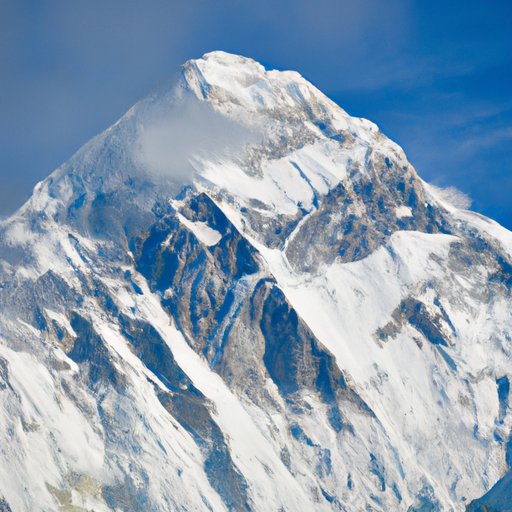Introduction
When we think of towering mountains, our minds often wander to legendary peaks like Mount Everest or K2 – but what are the tallest mountains in the world? This article will explore this question and provide an in-depth look at the highest peaks on each continent, as well as a comparison of the most impressive mountain ranges. We’ll also take a look at the history and geography behind the world’s tallest mountains, and round off with the hardest mountain climbing challenges.

Listicle of the Top 10 Tallest Mountains in the World
Let’s start by taking a look at the top 10 tallest mountains in the world. All of these mountains are located in the Himalayas and Karakoram mountain ranges, which span several countries in Asia, including Nepal, India, Pakistan, China, and Bhutan.
1. Mount Everest – Nepal/China (8,848m)
2. K2 – Pakistan/China (8,611m)
3. Kangchenjunga – India/Nepal (8,586m)
4. Lhotse – Nepal/China (8,516m)
5. Makalu – Nepal/China (8,485m)
6. Cho Oyu – Nepal/China (8,188m)
7. Dhaulagiri – Nepal (8,167m)
8. Manaslu – Nepal (8,163m)
9. Nanga Parbat – Pakistan (8,126m)
10. Annapurna – Nepal (8,091m)
An In-depth Look at the Highest Peaks on Each Continent
Now that we’ve looked at the world’s highest mountains, let’s take a closer look at the highest peaks on each continent:
Africa: Mount Kilimanjaro (5,895m)
Antarctica: Vinson Massif (4,897m)
Asia: Mount Everest (8,848m)
Europe: Mount Elbrus (5,642m)
North America: Denali (6,190m)
South America: Aconcagua (6,962m)
A Comparison of the Most Impressive Mountain Ranges
The world’s highest mountains are all located in the Himalayas and Karakoram mountain ranges, but there are many other impressive mountain ranges in the world. Here is a comparison of some of the most impressive mountain ranges:
The Himalayas: The Himalayas are the highest mountain range in the world, stretching across eight countries in South Asia. It contains the world’s highest peak, Mount Everest, as well as several other impressive peaks.
The Andes: The Andes are the longest continental mountain range in the world, stretching along the western coast of South America. They contain the highest peak outside of Asia, Aconcagua, as well as several active volcanoes.
The Rockies: The Rocky Mountains are a major mountain range in North America, stretching from Alaska to New Mexico. They contain several impressive peaks, including the highest peak in the US, Denali.
The Alps: The Alps are one of the most famous mountain ranges in Europe, stretching across eight countries. They contain some of the most popular ski resorts in the world, as well as iconic peaks like the Matterhorn.
The History and Geography Behind the World’s Tallest Mountains
Mountains are formed by tectonic plates pushing against each other, causing the earth’s crust to buckle and form mountains. The world’s tallest mountains are all located in the same area because of the collision of two tectonic plates – the Indian Plate and the Eurasian Plate.
Throughout history, many famous explorers have attempted to climb the world’s tallest mountains. The first successful summit of Mount Everest was achieved in 1953 by Sir Edmund Hillary and Tenzing Norgay. Since then, many more people have successfully climbed to the summit of Mount Everest, though it remains a challenging and dangerous endeavor.
There are many interesting facts about the world’s tallest mountains. For example, Mount Everest is not the tallest mountain when measured from base to peak – that honor belongs to Mauna Kea in Hawaii. Additionally, Mount Everest is constantly growing due to the movement of tectonic plates.
A Round-up of the Hardest Mountain Climbing Challenges
Climbing the world’s tallest mountains is no easy feat. Here is a list of the three hardest mountain climbing challenges:
1. Mount Everest: As the highest peak in the world, Mount Everest is the ultimate challenge for any mountaineer. Many climbers have attempted to reach the summit, but only a handful have been successful.
2. K2: Located in the Karakoram mountain range, K2 is the second-highest mountain in the world. It is considered to be the most difficult climb in the world due to its steep terrain and unpredictable weather.
3. Kangchenjunga: The third-highest mountain in the world, Kangchenjunga is located in the eastern Himalayas. It is known for its treacherous glaciers, making it a difficult and dangerous climb.
Conclusion
In this article, we explored the world’s tallest mountains and took an in-depth look at the highest peaks on each continent, as well as a comparison of the most impressive mountain ranges. We also discussed the history and geography behind the world’s tallest mountains, and rounded off with the hardest mountain climbing challenges.
For those interested in learning more about the world’s tallest mountains, there is plenty of further reading available online. From books to blogs to documentaries, you’ll find plenty of resources to help you explore the fascinating world of mountain climbing.


